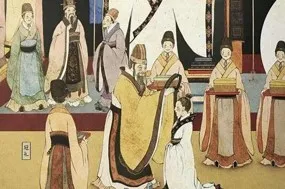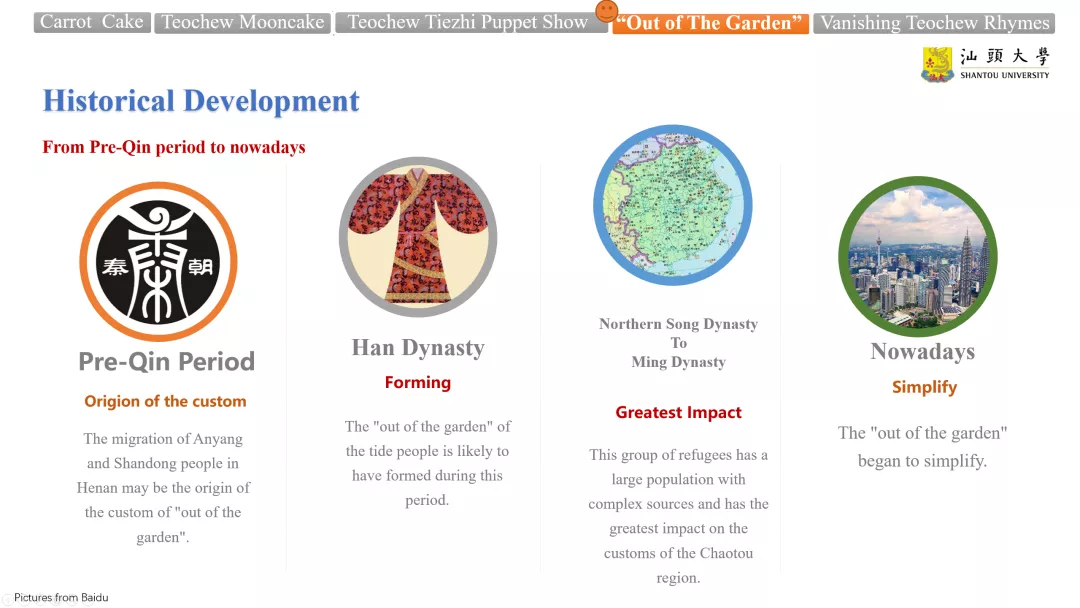2021/11/22
Teochew Rites of Passage("out of the garden")-出花园
Historical Developments
Pre-Qin Period
According to the relevant historians, as early as the pre-Qin period, people from Henan Anyang and Shandong moved into Chaoshan area, and the culture brought about by the migration had the first influence on the culture of Chaoshan area. The migration of Anyang and Shandong people in Henan may be the origin of the custom of "out of the garden",which is also known as rites of passage. Henan and Shandong were the political and cultural centers and the hinterland of the Central Plains at that time. "Crown ceremony" is more prevalent among the nobleman. The population's migration also brought the crown ceremony customs which was popular among nobleman in Central Plains region into Chaotou area. “Crown ceremony” was accepted and reformed by Chaoshan people, being a characteristic style of adult ceremony called "out of the garden".

Han Dynasty
Chaoshan in the Early Han Dynasty was Minyue region. The "out of the garden" is likely to have formed during this period. From the literature, the Customs of the Min Yue region are related with flowers. And the Chaoshan area of the Han Dynasty belongs to Minyue region, "out of the garden" process also used twelve kinds of flowers and plants. From these circumstances, we can suppose that in this period, rites of passage began to develop from the "crown ceremony" into the folk "out of the garden".
From the end of the Northern Song Dynasty to the end of the Yuan Dynasty and the beginning of the Ming Dynasty
Years of war in the north have caused many refugees to flee along Zhejiang Province into the present-day Chaoshan region, and the population has soared from 30,000 to 600,000. This group of refugees has a large population with complex sources and the greatest impact on the customs of the Chaoshan region. The complexity of population sources has further exacerbated the ten-mile variation in vulgarity. The foreign population in different regions has its own unique customs and is unwilling to change them easily . However, they can not get too far away from the local customs of Chaozhou in order to integrate into the local life of Chaozhou as soon as possible. Therefore, in the aspect of customs, mostly in accordance with and based on Chaozhou's original customs, to enrich and develop the content of various customs with their original customs. The combination of diverse cultures forms a distinctive tide culture, which is also the characteristic of "out of the garden".
Nowadays
With the development of the society, the cumbersome traditional "out of the garden" custom, is also changing. In some of the town's residential families, the "out of the garden" also began to simplify. Of course, the main worship process has not changed, but the offering has become simpler, the precautions are not as elaborate as before.

For example, the "redwood" was replaced by red sports shoes, "belly pocket" was replaced by red jacket. And the oblation is not so exquisite, pig liver represented the previous need for a variety of pig internal organs. Then some black bean wine was also cancelled, and "three animals" was replaced by fried chicken wings which children like to eat. People couldn’t go out before, now it's just not going so far.

Cause
Ancient (Rise and Pass On)
The migration of a diverse foreign population. Chaozhou region in different periods integrating different foreign ethnic groups. Many foreign ethnic groups have brought far-reaching influence and changes to the development of local folk culture. As an important part of folk culture and in the run-in and blend of various cultures, "out of the garden" had a characteristic route.
The "Crown ceremony" gradually micro. With the change of political system and way of life, the local history from Qing dynasty to the Republic of China can often be seen in the record of "Crown ceremony been abandoned for a long-term". At the same time, a variety of customs with ethnic customs and regional characteristics were widely popular in Chinese people’s daily life, such as "out of the garden" in Guangdong Chaoshan area.
The Chaoshan dialect, which is the medium of communication, is preserved. After Chaozhou dialect was formed as an independent language, it was more conservative and independent than Hakka, Cantonese and Minnan dialects, which made Chaoshan dialect gain tenacity. The complete Chaoshan dialect system is beneficial to the inheritance and development of traditional folklore.
Modern (Simplified)
Influenced by the political movement of reform and opening-up and the post-modern ideological movement, Chinese society is forming a daily life supported by modern technology and wealth that mixes cultural elements from China to abroad.The traditional "out of the garden" custom presents the trend of industrialization and fashion in modern society.
The pace of life accelerates. In the survey, we found that in addition to the "out of the garden" custom changes, the economic life, social style around this custom have a certain degree of change. For example, according to traditional customs , grandmothers and uncles must give away new clothes and shoes when their children " go out of the garden " , and new clothes and shoes used to be handmade , but now family members have no time to make them by themselves. Instead they purchase clothes, which has given birth to the production and retailing of " out of the garden " supplies.
Changes in ideology. Today, most Chaoshan people only regard the "out of the garden" custom as a ritual to express their blessing to their children to grow up, rather than thinking that children must experience the "out of the garden" custom in order to grow up peacefully.
Laws and regulations relating to intangible cultural heritage need to be further implemented. The government attaches great importance to the protection of intangible cultural heritage and has promulgated the Law of the People's Republic of China on Intangible Cultural Heritage, which has programmatic guidance on the protection of intangible cultural heritage in China. However, the study found that the current situation can be done "law-abiding", but intangible cultural heritage related laws and regulations need to be further implemented. And some residents lack the awareness of intangible cultural heritage protection, resulting in intangible cultural heritage can not be well inherited.
Lack of non-material cultural heritage talents. With the constant change and development of social environment, especially the development of new media, directly or indirectly affecting everyone's life. The cultural diversity presented by society has had an impact on intangible culture and traditional culture. Young people today are more inclined to pay attention to today's trend culture and learn less about non-material culture, which causes the lack of the non-material cultural heritage talents.
The path and method of transmission need to be improved. According to the survey, the protection of intangible cultural heritage in Chaoshan area is only limited to the government, academic institutions, and other official communities to carry out publicity and protection. Its communication methods, organizational methods and research input efforts need to be improved, which to a certain extent restricts the reproduction and spread of traditional culture.

Summary
Teochew Rites of Passage is an effective way to help young people recognize themselves, understand the world and adapt to society, and it is also a means to strengthen their adult consciousness and self-education ability. The most important factor in determining whether the "out of the garden" custom can exist in the long term is whether it can still assume the corresponding social functions and contribute to the positive growth of modern teenagers. In modern society, although the form of Teochew Rites of Passage has changed after hundreds of years, its basic ritual structure has not changed. How to promote it to keep pace with the times, how to make it closer to the daily life of people and the real needs of young people in content and form, how to extract the wisdom of folk education contained in the custom of Teochew Rites of Passage and provide reference suggestions for the adult ceremony in the current school are all meaningful and interesting subjects that require further in depth consideration.